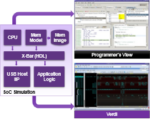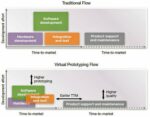Hot on the heels of DVConUS 2025, the 35th annual Synopsys User Group (SNUG) Conference made its mark as a defining moment in the evolution of Synopsys—and the broader electronic design automation (EDA) industry. This year’s milestone event not only underscored Synopsys’ continued innovation but also affirmed the vision… Read More
Author: Lauro Rizzatti
SNUG 2025: A Watershed Moment for EDA – Part 1
DVCon 2025: AI and the Future of Verification Take Center Stage
The 2025 Design and Verification Conference (DVCon) was a four-day event packed with insightful discussions, cutting-edge technology showcases, and thought-provoking debates. The conference agenda included a rich mix of tutorial sessions, a keynote presentation, a panel discussion, and an exhibit hall with Electronic… Read More
The Double-Edged Sword of AI Processors: Batch Sizes, Token Rates, and the Hardware Hurdles in Large Language Model Processing
Unlike traditional software programming, AI software modeling represents a transformative paradigm shift, reshaping methodologies, redefining execution processes, and driving significant advancements in AI processors requirements.
Software Programming versus AI Modeling: A Fundamental Paradigm Shift
Traditional… Read More
A Deep Dive into SoC Performance Analysis: Optimizing SoC Design Performance Via Hardware-Assisted Verification Platforms
Part 2 of 2 – Performance Validation Across Hardware Blocks and Firmware in SoC Designs
Part 2 explores the performance validation process across hardware blocks and firmware in System-on-Chip (SoC) designs, emphasizing the critical role of Hardware-Assisted Verification (HAV) platforms. It outlines the validation workflow… Read More
A Deep Dive into SoC Performance Analysis: What, Why, and How
Part 1 of 2 – Essential Performance Metrics to Validate SoC Performance Analysis
Part 1 provides an overview of the key performance metrics across three foundational blocks of System-on-Chip (SoC) designs that are vital for success in the rapidly evolving semiconductor industry and presents a holistic approach to optimize… Read More
SystemReady Certified: Ensuring Effortless Out-of-the-Box Arm Processor Deployments
When contemplating the Lego-like hardware and software structure of a leading system-on-chip (SoC) design, a mathematically inclined mind might marvel at the tantalizing array of combinatorial possibilities among its hardware and software components. In contrast, the engineering team tasked with its validation may have… Read More
The Immensity of Software Development and the Challenges of Debugging Series (Part 4 of 4)
The Impact of AI on Software and Hardware Development
Part 4 of this series analyzes how AI algorithmic processing is transforming software structures and significantly modifying processing hardware. It explores the marginalization of the traditional CPU architecture and demonstrates how software is increasingly dominating… Read More
The Immensity of Software Development and the Challenges of Debugging (Part 3 of 4)
Part 3 of this 4-part series analyzes methods and tools involved in debugging software at different layers of the software stack.
Software debugging involves identifying and resolving issues ranging from functional misbehaviors to crashes. The essential requirement for validating software programs is the ability to monitor… Read More
The Immensity of Software Development and the Challenges of Debugging Series (Part 2 of 4)
Part 2 of this 4-part series reviews the role of virtual prototypes as stand-alone tools and their use in hybrid emulation for early software validation, a practice known as the “shift-left” methodology. It assesses the differences among these approaches, focusing on their pros and cons.
The Immensity of Software Development the Challenges of Debugging (Part 1 of 4)
Part 1 of this 4-part series introduces the complexities of developing and bringing up the entire software stack on a System on Chip (SoC) or Multi-die system. It explores various approaches to deployment, highlighting their specific objectives and the unique challenges they address.
Introduction
As the saying goes, it’s… Read More

















The Quantum Threat: Why Industrial Control Systems Must Be Ready and How PQShield Is Leading the Defense